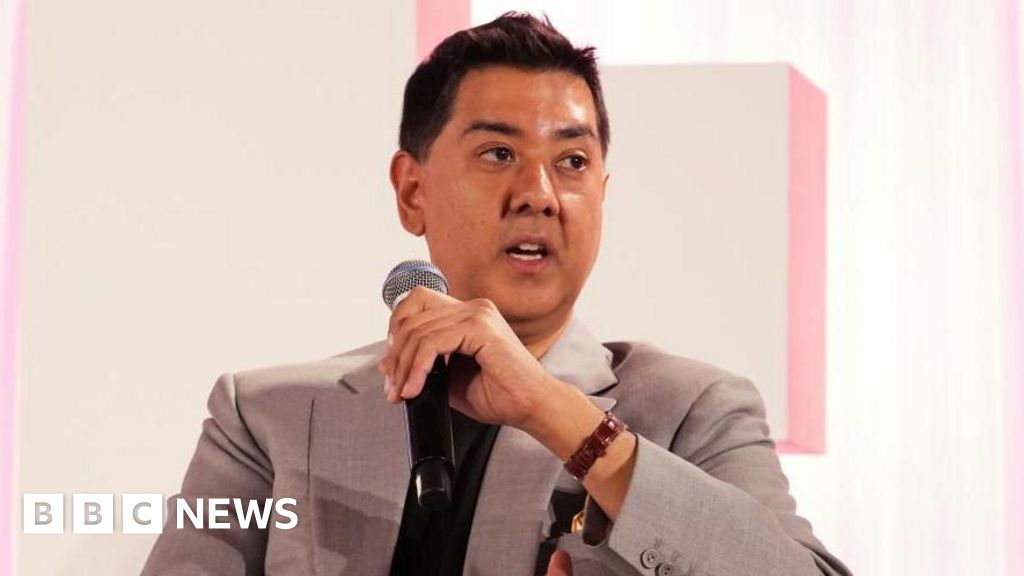Business
Parents say Jersey is ‘not as family-friendly as it should be’

 BBC
BBCWith its beautiful beaches, low crime rate and small community, Jersey is often considered an attractive place to raise children.
But parents have told the BBC that high costs and a lack of effective support from politicians and employers mean the island does not cater to families as well as it could.
Mother to a one and three-year-old, Katherine Jauncey said she believed there needed to be a “cultural shift” away from prioritising the social wellbeing of older islanders to focus on parents and children.
The island’s government said it understood families struggled with the high cost of living and it had set up several initiatives “aimed at improving family life in Jersey”.
Mrs Jauncey moved to Jersey with her husband who was born and raised there.
She said some aspects of bringing up her children on the island were “really great”, such as how safe it was and the system of state-supported private schools.
However, she added: “Families and individuals with children are really not prioritised in Jersey culture”.
“There’s a work culture that is unfairly weighted on the side of the employer… and the fact that our culture as an island is very much directed towards the elderly who have a large amount of the voting power.”
She said the island was “focused on the people who are shouting the loudest”, adding that often older people were the ones with the time and energy to do so.
‘Lack of childcare’
Mrs Jauncey said, despite a push to get women in particular back into the workforce, there was a “lack of support for parents with children under five” made worse by a “lack of affordable childcare”.
A report prepared for the government in 2024 found average childcare fees in Jersey were almost 50% higher than in England, while a survey of parents found 95% of those asked thought childcare was too expensive.
The government has announced plans to introduce an additional 15 free hours of nursery care per week for two-year-olds, but there has been concern from parents and nursery staff that it will not be enough.

Family campaigner and mother-of-three Denise Heavey said her own experience of paying nursery fees was “financially crippling”.
“Some months we were paying £2,200 and that was my salary swallowed up,” she said.
She kept working while her children were young but said a lot of parents were “forced out of the workplace because of the high cost of nursery care”.
To remedy this, she said the government needed to think about greater financial support for parents, particularly when returning to work after parental leave.
She added that businesses should also work harder to implement family-friendly policies, such as flexible working arrangements.
Mrs Jauncey has also called for greater statutory rights for working parents, including specific days outside annual leave to look after sick children.

It is not just the cost of childcare that is a cause for concern.
Single mother Karla Divin said the cost of living as a whole was the “most dominant concern” for parents.
In Jersey, prices are continuing to rise with the latest figures showing inflation at 2.8%.
Ms Divin said: “Childcare fees, rent, household bills, food and general expenses often consume an entire monthly wage, leaving little to no disposable income.”
She said this often meant families had to sacrifice experiences that could support a child’s development, such as school trips or extracurricular activities.
“Parents are often forced to prioritise essentials over opportunity,” she said.
Errol Mittoo, a father of four, told the BBC the island had a lot to offer young people but the “cost of bringing up a family was quite high”.
“You do struggle a bit when you’ve got children.”
What is the government doing to help?
In a statement, the government told the BBC it has introduced several measures to make lives better for families in Jersey. These included:
Alongside increased support for the nursery sector, ministers also said they had plans to publish a new play strategy to make sure children could play in all residential areas.
‘Look at solutions’
Outside government, a number of charities and individuals have stepped in to provide support.
Mrs Heavey, for example, has recently launched MentorHood, a community network offering support groups, workshops and meet ups to parents and caregivers in Jersey.
She has set up the group with another mother, Alice Vincenti, to build parents’ confidence and help them be “better performers at work and and be more present parents at home”.
However, she said it was “incredibly frustrating as a parent” that they were having to provide information and help to their peers when the government could make it readily available.
Mrs Heavey said she would like to see politicians making bold choices about childcare and support for parents, considering solutions on a much longer timeline than one political term.
She said this was a necessity given Jersey’s ageing population.
She said: “We can’t just keep saying with every new government that goes in that we’re going to basically start a project and it’s going to stop and then we start again.
“We have such a wonderful island and I think that we can be very, very family-focused, and we can look at solutions to encourage more people to bring their families here too, you know; have more children and to want to stay on the island.”
Business
Apollo Techno Industries IPO Last Day: Issue Receives 50.63x Subscription; GMP Rises To 9.23%

Last Updated:
Unlisted shares of Apollo Techno Industries are trading at Rs 136 apiece in the grey market, which is 4.6% premium over the issue price of Rs 130, indicating weak listing.
Apollo Techno Industries IPO.
Apollo Techno Industries IPO GMP: The initial public offering (IPO) of Apollo Techno Industries Ltd (ATIL) has been closed today, Friday, December 26. The price band of the Rs 47.96-crore IPO has been fixed in the range of Rs 123 and Rs 130. On the final day of bidding on Friday, the IPO received a total of 50.63x times subscription, garnering bids for 12,42,53,000 shares as against 24,54,000 shares on offer.
Its retail category got a 44.81x subscription, while its non-institutional investor (NII) quota got a 98x subscription. Its qualified institutional buyer (QIB) category has received a 25.26x subscription.
ATIL is a manufacturer specialising in trenchless technology and foundation equipment for the construction industry
Apollo Techno Industries IPO GMP Today
According to market observers, unlisted shares of Apollo Techno Industries Ltd are currently trading at Rs 142 apiece in the grey market, which is a 9.23 per cent premium over the issue price of Rs 130. It indicates a weak listing. Its listing will take place on December 31, Wednesday.
The GMP had stood at 4.62 per cent in the morning.
The GMP is based on market sentiments and keeps changing. ‘Grey market premium’ indicates investors’ readiness to pay more than the issue price.
Apollo Techno Industries IPO: More Details
The Apollo Techno Industries Limited IPO is a book-built issue worth ₹47.96 crore, comprising only a fresh issue of 0.37 crore equity shares. There is no offer-for-sale component in the issue.
The IPO opened for subscription on December 23, 2025, and will close on December 26, 2025. The basis of allotment is expected to be finalised on December 29, 2025, while the shares are scheduled to list on the BSE SME platform on December 31, 2025, subject to approvals.
The price band for the issue has been fixed at Rs 123 to Rs 130 per share. The lot size is 1,000 shares. Retail investors are required to apply for a minimum of 2 lots (2,000 shares), translating into an investment of Rs 2.60 lakh at the upper end of the price band. For HNIs, the minimum application size is 3 lots (3,000 shares), amounting to Rs 3.90 lakh.
Beeline Capital Advisors Pvt Ltd is the book running lead manager to the issue, while MUFG Intime India Pvt Ltd is acting as the registrar. The market-making duties will be handled by Spread X Securities Pvt Ltd.
Apollo Techno Industries reported strong financial growth in FY25. The company’s revenue rose 44 percent, while profit after tax (PAT) surged 327 percent for the year ended March 31, 2025, compared with the previous financial year.
Incorporated in 2016, Apollo Techno Industries operates in the manufacturing and technology space, with a focus on equipment used in the construction and infrastructure sector.
The company specialises in trenchless technology and foundation equipment, catering to complex construction requirements. Its product portfolio includes Horizontal Directional Drilling (HDD) rigs, Diaphragm Drilling Rigs, Rotary Drilling Rigs, along with associated spare parts.
December 26, 2025, 10:51 IST
Read More
Business
New BIS standard for incense sticks: Govt bans certain substances; flags ‘potential impact on human health’ – The Times of India

NEW DELHI: The government issued a notification announcing a new Indian Standard for incense sticks (agarbatti), laying down quality norms and specifying a list of substances prohibited for use in their manufacture.The standard has been developed by the Bureau of Indian Standards (BIS) to ensure safer products and promote responsible and sustainable practices in the incense stick industry, the minister for consumer affairs said in a statement released on National Consumer Day 2025.The ministry released a list of harmful substances. “This includes certain insecticidal chemicals such as alethrin, permethrin, cypermethrin, deltamethrin, and fipronil, as well as synthetic fragrance intermediates like benzyl cyanide, ethyl acrylate, and diphenylamine. Many of these substances are restricted or banned internationally due to their potential impact on human health, indoor air quality, and ecological safety,” it said.According to the notification, the standard classifies agarbattis into machine-made, hand-made, and traditional masala agarbattis, and prescribes norms for raw materials, burning quality, fragrance performance and chemical parameters. This, the ministry said, will ensure safer products and consistent quality for consumers.Agarbattis are deeply embedded in India’s cultural and religious life and are widely used in homes, places of worship, meditation centres.With rising global demand for incense products growing steadily in India and overseas, the international studies and regulatory developments, “particularly in Europe have raised concerns over the use of certain synthetic chemicals in fragranced products, including incense sticks,” the release stated.Some of these substances have been linked to respiratory irritation, allergic reactions, neurological effects and environmental harm when used repeatedly in indoor environments, it added.The standard has been developed by the Fragrance and Flavour Sectional Committee (PCD 18) of BIS after extensive consultations with stakeholders.India is the world’s largest producer and exporter of agarbattis. The industry is estimated at around Rs 8,000 crore annually, with exports worth nearly Rs 1,200 crore to over 150 countries, including the US, Malaysia, Nigeria, Brazil and Mexico.The sector supports a large network of artisans, micro-entrepreneurs and MSMEs, especially in rural and semi-urban areas, and plays a key role in generating employment, particularly for women.The government said the new standard is “expected to enhance consumer confidence, promote ethical and sustainable manufacturing practices, support traditional artisans, and improve access to global markets. The standard reinforces India’s commitment to protecting its cultural heritage while aligning indigenous industries with modern quality and safety expectations. Products complying with this standard can also carry the BIS Standard Mark, helping consumers make informed choices with confidence.“
Business
US judge blocks detention of British social media campaigner

A US judge has temporarily blocked the detention of British social media campaigner Imran Ahmed, who took legal action against the US government over having his visa removed.
The Center for Countering Digital Hate founder was among five people denied US visas after the Trump administration accused them of seeking to “coerce” tech platforms into censoring free speech.
The move brought a backlash from European leaders defending the work of organisations monitoring online content.
Mr Ahmed, a US permanent resident, had warned that being detained and possibly deported would tear him away from his American wife and child. Praising the judge’s decision, he told BBC News he would not be “bullied”.
Secretary of State Marco Rubio had said online that the individuals were blocked over concerns that they had organised efforts to pressure US platforms to censor and “punish American viewpoints they oppose“.
Mr Ahmed filed a legal complaint on Wednesday against officials including Rubio and US Attorney General Pamela Bondi over the decision to have him sanctioned.
In court documents seen by the BBC, US District Judge Vernon S Broderick said on Thursday he had granted Mr Ahmed’s request for a temporary restraining order.
The judge also temporarily blocked the officials from detaining Mr Ahmed without the chance for his case to be heard.
The BBC has contacted the state department and White House for comment.
When approached by AFP news agency, a state department spokesperson was quoted as saying: “The Supreme Court and Congress have repeatedly made clear: the United States is under no obligation to allow foreign aliens to come to our country or reside here.”
Mr Ahmed said: “I will not be bullied away from my life’s work of fighting to keep children safe from social media’s harm and stopping antisemitism online.”
His lawyer, Roberta Kaplan, said the speed of the judge’s decision was telling.
“The federal government can’t deport a green card holder like Imran Ahmed, with a wife and young child who are American, simply because it doesn’t like what he has to say,” she said.
In 2023, Mr Ahmed’s centre was sued by Elon Musk’s social media company after it reported on a rise in hate speech on the platform since the billionaire’s takeover of the firm, now called X.
The case was dismissed but an appeal is pending.
-

 Fashion1 week ago
Fashion1 week agoIndonesia’s thrift surge fuels waste and textile industry woes
-

 Business1 week ago
Business1 week agoBP names new boss as current CEO leaves after less than two years
-

 Tech1 week ago
Tech1 week agoT-Mobile Business Internet and Phone Deals
-

 Sports1 week ago
Sports1 week agoPKF summons meeting after Pakistani player represents India in kabaddi tournament
-

 Entertainment1 week ago
Entertainment1 week agoIndia streamlines visa rules in boost for Chinese professionals
-

 Sports1 week ago
Sports1 week agoUWCL grades for all 18 teams: Leuven get A+; Barça an A-, PSG fail
-
Sports6 days ago
Alabama turned Oklahoma’s College Football Playoff dream into a nightmare
-

 Entertainment1 week ago
Entertainment1 week agoRadiation fears rise after cracks found in $2 billion Chernobyl shield







